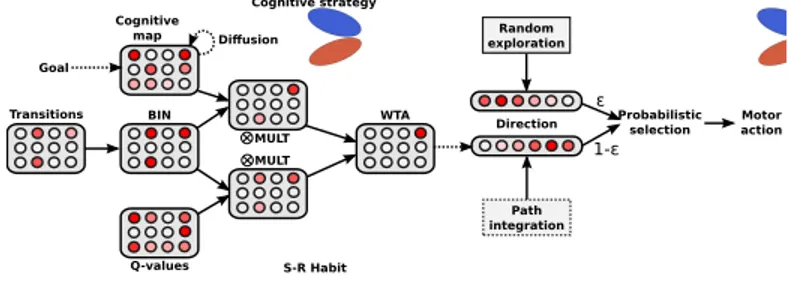HAL Id: hal-01063964
https://hal.archives-ouvertes.fr/hal-01063964
Submitted on 15 Sep 2014
HAL is a multi-disciplinary open access
archive for the deposit and dissemination of
sci-entific research documents, whether they are
pub-lished or not. The documents may come from
teaching and research institutions in France or
abroad, or from public or private research centers.
L’archive ouverte pluridisciplinaire HAL, est
destinée au dépôt et à la diffusion de documents
scientifiques de niveau recherche, publiés ou non,
émanant des établissements d’enseignement et de
recherche français ou étrangers, des laboratoires
publics ou privés.
Cooperation of S-R habit and cognitive learnings in
goal-oriented navigation
Souheïl Hanoune, Jean-Paul Banquet, Mathias Quoy, Philippe Gaussier
To cite this version:
Souheïl Hanoune, Jean-Paul Banquet, Mathias Quoy, Philippe Gaussier. Cooperation of S-R habit and
cognitive learnings in goal-oriented navigation. SBDM 2014 Paris France, May 2014, Paris, France.
pp.42-43. �hal-01063964�
Fourth International Symposium on Biology of Decision Making
SBDM2014
Cooperation of S-R habit and cognitive learnings in goal-oriented
navigation
Souheïl Hanoune1 2, Jean Paul Banquet2, Mathias Quoy1 2, Philippe Gaussier1 2
1University of Cergy Pontoise, France. 2ETIS lab, UMR 8051 CNRS, University of Cergy-Pontoise, ENSEA, France.
e-mail: {souheil.hanoune, quoy, gaussier}@ensea.fr
The Stimulus-Response (S-R) theory and Tolman’s Cognitive Theory of behavior control both issued from behaviorism in the early XXth century still provide a relevant general framework to account for animal reward-based adaptive behavior. In this paper, we propose a new paradigm for representing and implementing both the cognitive strategy and the S-R habit strategy within a unitary coding frame. Based on a parallel learning of both strategies, the model explains how the fast learning cognitive strategy can supervise and accelerate the slow learning S-R habit strategy. This parallel representation is inspired by the cortico-basal functional loops [Alexander et. al., 1986] and the cooperation between the cognitive associative loop, including the dorso-medial striatum and the mPF; and the sensory-motor loop, associated to the sensory motor cortex in relation with the dorso-lateral striatum.
The implementation of S-R habit strategy is different from a classical Q-learning and is based on the model of [Hirel et al., 2013], representing the functioning of the sensory-motor loop. This representation is based on a neuronal modelisation of the Q-learning algorithm. The states of the model are represented by the transitions. A transition is an association between two consecutive place-cells during the exploration of the environment, learned in the CA1-CA3 regions of the hippocampus. The cognitive strategy is based on a map representation of the environment namely the cognitive map [O’Keefe & Nadel, 1978]. Based on the association between learned transitions, the cognitive map allows the back-propagation of a reward within a tree, allowing the selection of the shortest path to the goal. While the cognitive map is quickly learned, the Q-values associated with the Q-learning are slower to acquire. On the other hand, the Q-learning tends to be more accurate than the cognitive map when fully learned.
The model exploits this speed difference in its parallel learning. The fast acquisition of the cognitive map allows the robot to quickly choose correct paths to the goal, and thus the time convergence of the Q-learning algorithm is optimized. The cooperation is based on the biasing of the selected transition by the cognitive map and the Q-learning in parallel (see Fig 1). In its early learning stage, the Q-learning biasing is too weak, and the cognitive map is dominant, inducing the supervision of the S-R habit by the cognitive strategy. In the later learning stages, the Q-learning is stronger and more precise. Cooperation of the cognitive strategy and S-R habit enables a faster S-R learning; as shown on Fig 2. It is also possible to study the lesioning of one or the other path and its effect on the behavior and the learning process.
Transitions BIN Cognitive map MULT WTA Direction Random exploration Path integration Q-values MULT Motor action Cognitive strategy S-R Habit ε 1-ε Probabilistic selection Goal Diffusion
Figure 1: Cooperative architecture of the cognitive strategy and the S-R habit.
T = 7.6 s
σ = 2.5 s T = 7.1 sσ = 1.3 s
Ti
me
Number of trials
With cognitive map No cognitive map T = 9.0 s σ = 6.3 s Ti m e No cognitive map Number of trials
Figure 2: Example of convergence time of
the Q-learning with and without the cog-nitive supervision.
References
[Alexander et. al., 1986] Alexander, G E, DeLong, M R, Strick, P L (1986). Parallel organization of functionally segregated circuits linking basal ganglia and cortex. Annual Rev of Neurosci, 9(1):357–381.
[Banquet et al., 2014] Banquet, J. P., Gaussier, P., Quoy, M., Revel, A., Burnod, Y. (2014). A hierarchy of associations in hippocampo-cortical systems: cognitive maps and navigation strategies. Neural Comput., 17(6):1339–1384
[Hirel et al., 2013] Hirel, J., Gaussier, P., Quoy, M., Banquet, J.-P., Save, E., Poucet, B. The Hippocampo-cortical Loop: Spatio-Temporal Learning and Goal-oriented Planning in Navigation (2013). Neural Networks, 43,:8–21
[O’Keefe & Nadel, 1978] O’Keefe, J., Nadel, L. (1978). The hippocampus as a cognitive map. Oxford University Press.
